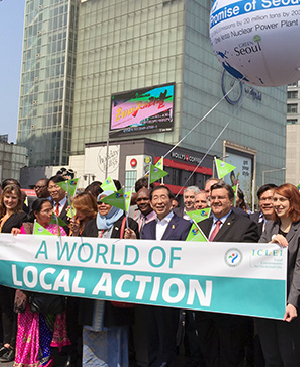- Home
- Reporting entities
- City of Maple Ridge
City of Maple Ridge
Canada Mayor: Nicole Read-
Population 76052

-
Area 266.78km 2
-
GDP N/AN/A
-
Targets by N/A N/Aemission
Targets by City of Maple Ridge
There are no targets yet
- Start year: 2009
- Type: Technical/Infrastructure investment
- Status: Completed
Maple Ridge Leisure Centre retrofit. This project included life-cycle cost effective and environmentally sustainable solutions for replacing or retrofitting key components of the central heating system and the natatorium ventilation/dehumidification. The facility underwent a number of extensive energy efficiency improvements, including an exhaust air reclaim system, a dehumidification reclaim system, filter and pump room air conditioning, a solar heating system with 24 solar collection panels, a new hot water heating system pump and the retrofitting of the second pump impeller. The District\'s Leisure Centre is a model for the community and for future municipal building renovations and capital construction projects. This project together with the District\'s Information Services new technology upgrades was the successful recipient of the Community Energy Association\'s 2010 award in the Corporate Operations category.
Read More Read Less- Buildings
- Start year: 2006
- Type: Technical/Infrastructure investment
- Status: In operation
Maple Ridge embraces the E3 Fleet Program. By the end of 2010, 27 of 40 small transportation vehicles in the municipal fleet were replaced with hybrid vehicles. From mid-2006 until the end of 2009, The District has saved 48,600 litres of fuel and eliminated 115 tonnes of greenhouse gas emissions as a result of incorporating hybrid vehicles into the fleet.
Read More Read Less- Transport

- Start year: 2008
- Type: Technical/Infrastructure investment
- Status: Completed
Following two years of expansion and renovations, the ribbon was finally cut on Fire Hall No. 1 on June 25, 2010. Renovations to the building have created much needed space for the fire crews, fire department administrative offices, the District\\\'s emergency operations centre, and a large training room.
In keeping with the District of Maple Ridge\\\'s commitment to environmental sustainability, the project is currently registered with the Canadian Green Building Council (CaGBC) and certification for Leadership in Energy and Environmental Design (LEED) is underway. Fire Hall No. 1 has sufficient points to achieve a Silver certification and is in striking distance of LEED Gold.
A \\\'green\\\' intent, along with the enthusiastic participation of the Fire Fighters\\\' Building Committee, influenced and shaped almost every design decision at various stages of the project, some of which are described below:
The addition / renovation project minimized use of new materials and maximized reuse of existing building shell and asphalted areas.
Mechanical systems have been carefully designed to be innovative and efficient. They are controlled and monitored by a Building Automation System restricting their use only to occupied areas and ensuring optimal functioning.
A closed loop geo-exchange system has been designed to meet the bulk of heating and cooling requirements. This option is extremely economical in the long run and reduces consumption of natural gas and greenhouse gas emissions.
Energy efficient electrical lighting fixtures are controlled by occupancy sensors, conserving electricity and lengthening the usable life of the fixtures.
Large windows on exterior walls, light shelves and extensive use of interior glazed partitions enable penetration of natural light to interior spaces. Natural lighting and ventilation reduces dependency on mechanical and electrical systems conserving energy.
The building envelope has been designed and detailed for optimum energy performance, expending less energy while heating building interiors. The roofing system was designed to increase reflectivity, effectively reducing heat within the building.
Landscaping has been designed using vegetation that is drought resistant. Low flush fixtures used in the washrooms further reduce water usage.
All the above points contribute towards making Maple Ridge Fire Hall No. 1 a sustainable, low energy building in terms of its construction, operation and maintenance.
- Buildings
- Start year: 2009
- Type: Organizational / Governance
- Status: In operation
Energy consumption is costly. To reduce the environmental and financial costs associated with energy consumption the District of Maple Ridge is actively looking for ways to decrease the amount of energy used corporately.
Through a partnership with BC Hydro, the District of Maple Ridge has obtained additional resources to monitor consumption patterns, identify areas for improvement, and implement energy reduction techniques.

- Start year: 2005
- Type: Technical/Infrastructure investment
- Status: Completed
Opening in May 1990, the building originally served as a Provincial Courthouse and was acquired by the District in 2004. Renovations began in 2005 to accommodate a number of community safety related services such as community policing, the RCMP auxiliary program, District Bylaws Department and the Ridge Meadows Youth Justice Advocacy Program. Over 180 volunteers involved in community safety initiatives are located out of this facility.
The Randy Herman Community Safety Building renovation was designed and constructed under the Leadership in Energy and Environmental Design Commercial Interiors rating system. The building has a number of green building features in its achievement of LEED Silver Certification.
Re-Using Existing Materials - 90% of the doors and frames were re-used; benches and millwork have been re-used or refurbished. The resilient flooring in the RCMP gym is made from recycled tires and other rubbers. 92% of the waste on site was recycled.
Healthy Building Materials - the carpet is made from recycled content and is Green Guard certified. All paints and adhesives have low Volatile Organic Compounds (VOC\\\'s). All new doors and millwork are made from wood that does not contain urea formaldehyde.
Water Reduction Strategies - Low flow fixtures were installed in all new changerooms and washrooms. Water closets now use 4.0 litres per flush vs. the standard 6.0 litres per flush. Faucets now use 1.9 litres per minute aerators vs. the standard 8.3 litres per minute.
Energy Reduction Strategies - All T12 ballast and incandescent light fixtures were replaced with more energy efficient T8 or compact fluorescent fixtures. T8 lights use four times less energy than a T12!
- Buildings
- Start year: 2010
- Type: Education/Awareness Raising
- Status: Completed
The District\\\'s Information Services staff adopted cost effective new technology which is considered a best practice for its impact on corporate operations and the environment. Using terminal services in combination with thin client hardware provides significant savings in terms of cost of equipment, maintenance, downtime, installing and updating software, and environmental impact. This project together with the retrofitting of the District\\\'s Leisure Centre was the successful recipient of the Community Energy Association\\\'s 2010 award in the Corporate Operations category.
Read More Read Less
- Start year: 2010
- Type: Regulatory
- Status: Completed
Adopted provincial solar hot water ready regulation requiring most new single family homes to be built to accommodate future installation of solar hot water systems for water heating.
Read More Read Less- Start year: 2011
- Type: Policy/Strategies/Action Plans
- Status: Completed
The policy focuses on the minimization of energy consumption where feasible/cost-effective, and asks that energy consumption information is reviewed prior to decision making that will have an impact on corporate energy consumption, as well as the practice of reviewing corporate operations to identify and implement energy efficiencies. It also advises employees to apply energy consumption best practices throughout the workday.
Read More Read Less
- Start year: 2011
- Type: Fiscal / Financial mechanism
- Status: In operation
The Revitalization Tax Exemption Program was established by bylaw to:
a. Encourage residential investment to diversify housing options, to increase density in
Maple Ridge\\\'s Town Centre, and to provide a larger base of residents to support Commercial
activities;
b. Encourage Commercial investment to create a strong local economy and expand employment opportunities for citizens;
c. Increase pedestrian traffic with added residential and Commercial activity, both to
support local business, and to enhance safety;
d. Encourage and support the use of environmentally sustainable building construction
methods and materials, and encourage energy efficiency and alternative
technologies.
The City of Maple Ridge has reported 2 Community emission inventories, since 2007. In its latest inventory, compiled in 2010, the Transport, Stationary energy and Waste management are identified as key emission sources.
The City of Maple Ridge has reported 8 government operational inventories, since 2007. In its latest inventory, compiled in 2014, the Transport, Other and Waste management are identified as key emission sources.
Mayor Nicole ReadCity of Maple Ridge, Canada


